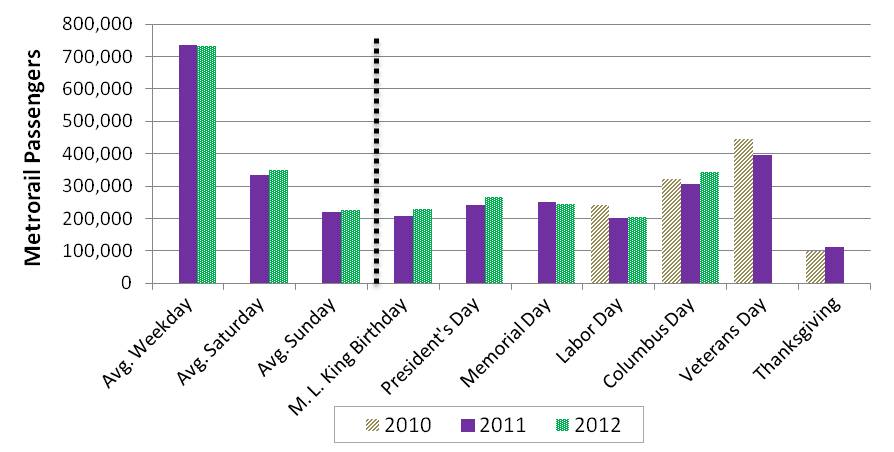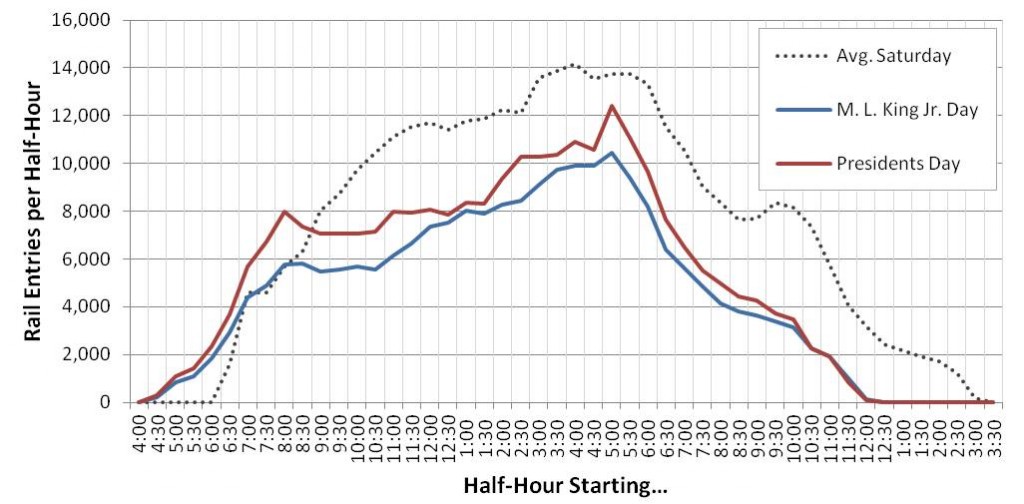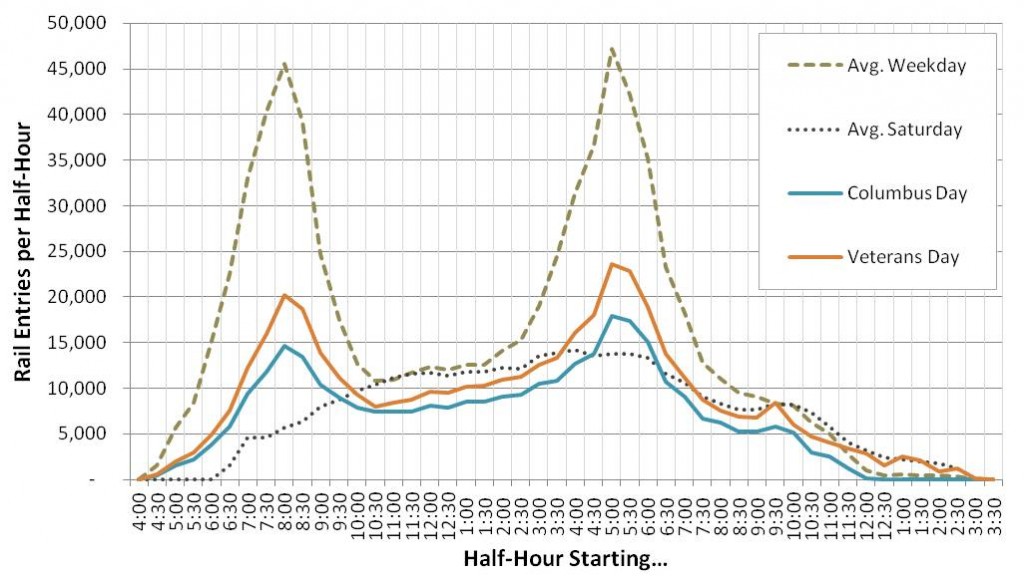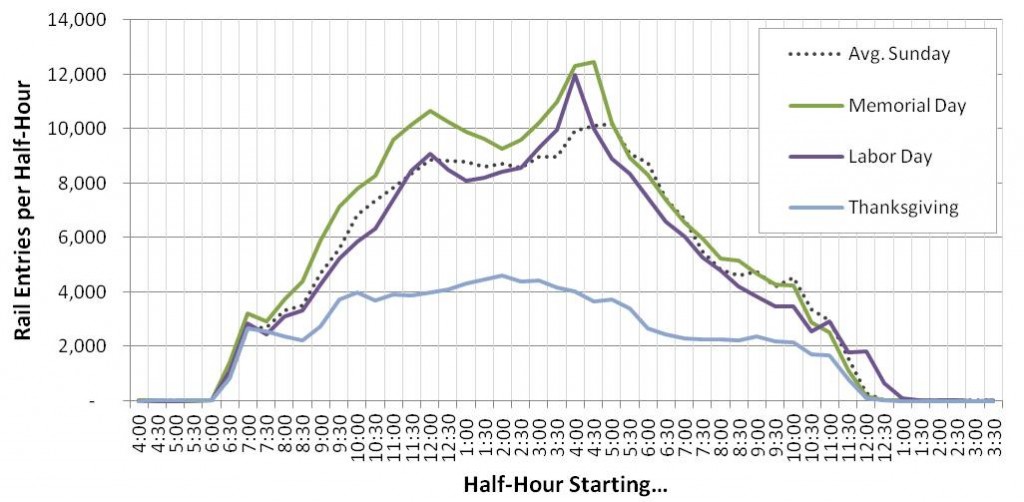What Happens to Metrorail Ridership on Holidays?
About ten days a year, Metrorail operates on a holiday schedule. On some holidays, most commuters have the day off, like Christmas, Labor Day, or Independence Day. But other days can be holidays for some, but not others – like Columbus Day, Veterans Day, or Martin Luther King, Jr. Birthday – and these often fall on a Monday or Friday to make a long weekend. Federal workers, whom we estimate at over a third of peak ridership, usually get these days off, as do others. Metro often uses some holidays to do trackwork. So what happens to rail ridership on holidays?
To answer this question, this post examines total ridership on holidays over the past few years, by holiday, and by time of day. I excluded Christmas, New Year’s Day, and Independence Day, since these holidays are strongly influenced by how they fall in the calendar, and by the events on the National Mall on Independence Day.
Here’s a look at ridership on the remaining 7 holiday weekdays. For the sake of comparison, I also show an average weekday, Saturday, and Sunday for May 2012.
So, all holidays shown have much lower ridership than a typical weekday, and are more in the range of a Saturday or Sunday. A typical weekday on Metrorail shows around 730,000 riders per day, with Saturdays about half that, and Sundays around a third of a weekday. The holidays shown above are in the range of 200,000 to 400,000 riders per day.
What if we look at this by hour – do some holidays look more like a “peaked” weekday vs. a weekend? The following charts show are the same holidays, by half-hour interval – averaged across the last 2-3 years, compared to typical May 2012 ridership levels.
The first chart shows holidays where Metrorail operates on a modified Saturday schedule, with a 5:00 am opening, and midnight closing.
The second chart shows holidays where Metrorail operates on a modified “Saturday Holiday” schedule, with a 5:00am opening, and where extra rail service beyond Saturday levels is provided at peak times. Veteran’s Day 2011 occurred on a Friday, so the system stayed open for late-night. A typical weekday is shown for the sake of comparison.
Columbus Day and Veterans Day show demand somewhere in between a weekday and a weekend. These two holidays show moderate peaks in usage around typical rush hours, but at a smaller scale than a typical weekday. As a result, Metro adds peak service on these days.
The last chart shows holidays where Metrorail operates on a Sunday schedule:
In response to these unique demand patterns, Metro adjusts theschedule as described above, and often uses the day to undertake trackwork. On Saturday Holiday schedules, extra service beyond normal Saturday levels is provided during peak times. All holiday rail schedules are modified to accommodate scheduled track work, if necessary. Here’s the holiday rail schedule, describing what service is provided on major holidays.






Let’s hope this is only the beginning of a wonderful new WMATA relationship sharing data with stakeholders. I hope at some point you will venture into differences by line, too. Lots of useful information could come from that.
I understand the statistics your trying to show and they make a lot of sense. I agree with you that track work on memorial day, labor day, and some of the other widely observed holidays makes sense. However; reducing the capacity of the trains and single tracking on the red line on November 12, 2012 was down right bad planning. A reduction of commuter traffic of 50% does not justify 40 minute wait times for trains. I agree that having less trains, which cause discomfort and minor inconvenience, during these days is fine considering you pay less on these days. On the other hand, when the trains become irregular and waits between them upwards of 20 minutes, this become ridiculous.
Regarding Veteran’s Day 2012, I think it may have been a good idea for metro to consider the circumstances surrounding that holiday. It is my feeling that a number of people used that holiday to make up a missed day or two from Sandy, and that contributed to an even greater number of rush-hour riders than may have been typically seen on your average Veteran’s Day. Car traffic appeared just as heavy as an average holiday in my opinion as well. Given those circumstances, it would have been wise for Metro to treat that day a little differently than an average Veteran’s day holiday.